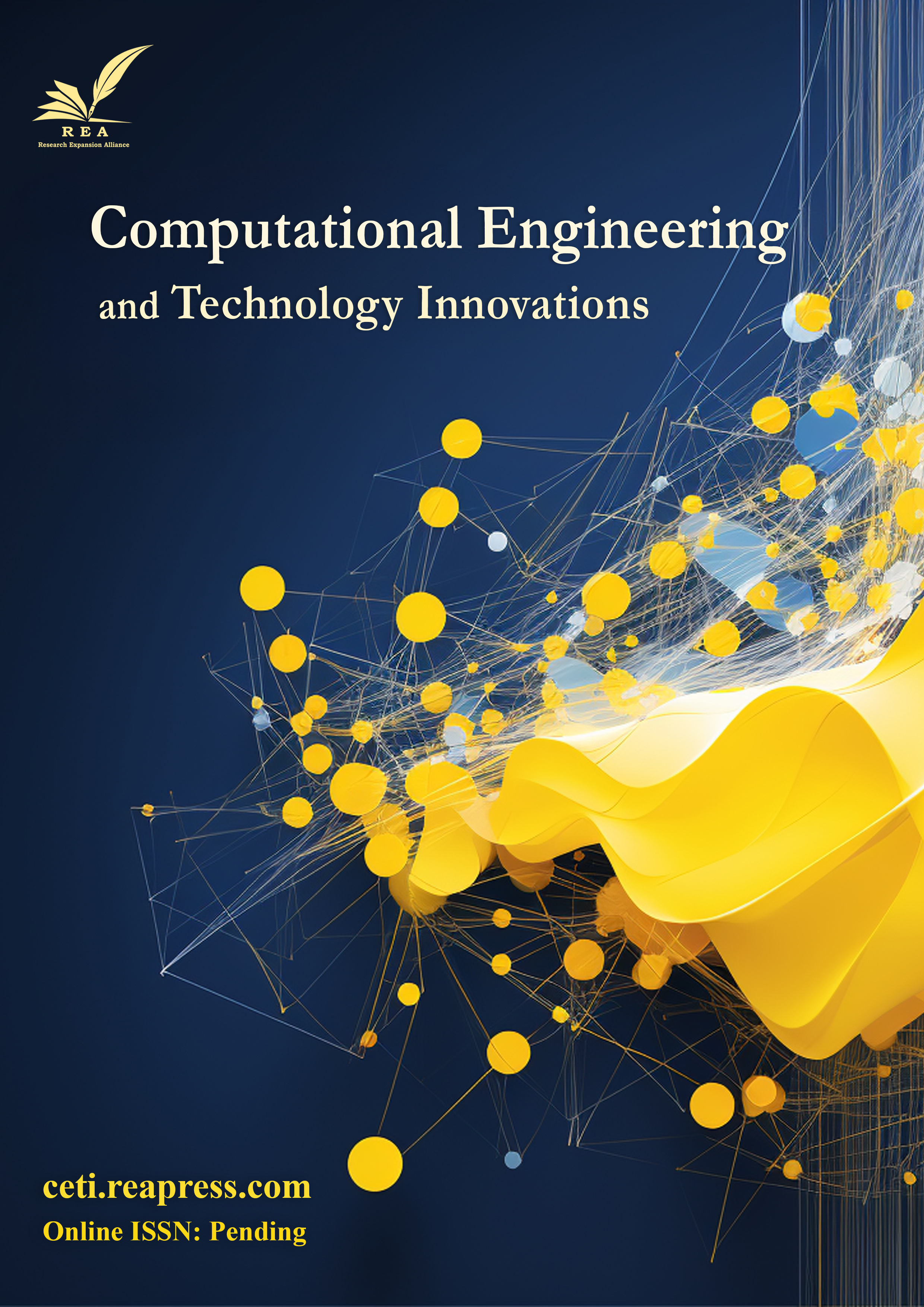Computational Modelling of Complex Physical Phenomena in TIG Weld Profile based on relationship between Coefficient of Thermal Expansion and Transient Temperature Variations in Mild Steel Plate
Abstract
To minimize welding experimental cost, time, and defects and prevent inaccurate results, finite element computational modelling and simulation were performed on AISI 1018 mild steel plate, which interacts seamlessly with Tungten Inert Gas (TIG) welding sequence due to its low carbon content. Goldak heat source distribution was employed to model the complex phenomena around the weld profile, considering convection and radiation heat losses in the thermal cycles to maintain a balance in the temperature gradients. The study focused on the heat input variation around the weld profile upper face and parallel plane situated 1.5 mm beneath the upper face to demystify the thermal behaviour of Coefficient of Thermal Expansion (CTE) and Transient Temperature Variations (TTVs) across the weld profile region. The heat input distributed across the parallel plane exhibited a different geometric profile compared to the upper face because heat input at this depth (1.5 mm parallel plane) is influenced by heat conducted via the base metal, the presence of any heat sinks or thermal barriers, and thermal conductivity of the base metal. The distribution of the heat input was observed to take after the geometric form of Gaussian distribution. Findings from the weld profiles revealed that maximum weld temperature of 1391, 1516, 1667, 2200, 2596 and 2834 oC yielded maximum CTE of 1.1e-014, 1.1e-012, 1.1e-011, 1.1e-009, 1.1e-007 and 1.1e-005 oC-1. From the trend of these values, it was observed that increasing weld temperatures obviously led to increasing CTE, which agrees with findings from existing research in this field of study. It was also noted that, at each of these CTE values, the corresponding thermal expansion lengths were 0.01, 0.03, 0.05, 0.07, 0.09, and 0.12 mm, indicating that increasing weld temperatures increased the corresponding CTE, which in turn led to an increase in the corresponding length of thermal expansion.
Keywords:
TIG welding, Computational modelling , Weld profile, Temperature variations , Thermal cycleReferences
- [1] Arora, H., Singh, R., & Brar, G. S. (2019). Thermal and structural modelling of arc welding processes: A literature review. Measurement and control, 52(7–8), 955–969. https://doi.org/10.1177/0020294019857747
- [2] Zhang, Y. M., Yang, Y. P., Zhang, W., & Na, S. J. (2020). Advanced welding manufacturing: A brief analysis and review of challenges and solutions. Journal of manufacturing science and engineering, 142(11). https://doi.org/10.1115/1.4047947
- [3] Hanninen, H., Aaltonen, P., Brederholm, A., Ehrnstén, U., Gripenberg, H., Toivonen, A., ... & Virkkunen, I. (2006). Dissimilar metal weld joints and their performance in nuclear power plant and oil refinery conditions. VTT tiedotteita, 2347(208). https://b2n.ir/q81932
- [4] Mohajernia, B., & Urbanic, J. (2023). Exploring computational techniques for simulating residual stresses for thin wall multi-joint hexagon configurations for a laser directed energy deposition process. The international journal of advanced manufacturing technology, 126(5), 2745–2763. https://doi.org/10.1007/s00170-023-11145-2
- [5] Verma, J., & Taiwade, R. V. (2017). Effect of welding processes and conditions on the microstructure, mechanical properties and corrosion resistance of duplex stainless steel weldments-A review. Journal of manufacturing processes, 25, 134–152. https://doi.org/10.1016/j.jmapro.2016.11.003
- [6] Singh, D. K., Sharma, V., Basu, R., & Eskandari, M. (2019). Understanding the effect of weld parameters on the microstructures and mechanical properties in dissimilar steel welds. Procedia manufacturing, 35, 986–991. https://doi.org/10.1016/j.promfg.2019.06.046
- [7] Ikpe, A. E., & Bassey, M. O. (2023). Modelling and simulation of transient thermal stress distribution across AISI 1018 flat plates at variable welding temperature regime. Journal of materials engineering, structures and computation, 2(3). https://doi.org/10.5281/zenodo.8297860
- [8] Huang, H., Yin, X., Feng, Z., & Ma, N. (2019). Finite element analysis and in-situ measurement of out-of-plane distortion in thin plate TIG welding. Materials, 12(1). https://doi.org/10.3390/ma12010141
- [9] Aissani, M., Guessasma, S., Zitouni, A., Hamzaoui, R., Bassir, D., & Benkedda, Y. (2015). Three-dimensional simulation of 304L steel TIG welding process: contribution of the thermal flux. Applied thermal engineering, 89, 822–832. https://doi.org/10.1016/j.applthermaleng.2015.06.035
- [10] BASSEY, M., Offiong, U., & Ikpe, A. (2023). Finite element simulation for thermo-mechanical transient behavior of mild steel plate agglutinated by gas tungsten arc welding (GTAW) technique. Journal of materials engineering, structures and computation, 2(3), 549–559. https://doi.org/10.5281/zenodo.8306756
- [11] Nezamdost, M. R., Esfahani, M. R. N., Hashemi, S. H., & Mirbozorgi, S. A. (2016). Investigation of temperature and residual stresses field of submerged arc welding by finite element method and experiments. The international journal of advanced manufacturing technology, 87(1), 615–624. https://doi.org/10.1007/s00170-016-8509-4
- [12] Beygi, R., Marques, E., & da Silva, L. F. (2022). Computational concepts in simulation of welding processes. Springer international publishing. http://dx.doi.org/10.1007/978-3-030-97910-2
- [13] Bassey, M. O., Ohwoekevwo, J. U., & Ikpe, A. E. (2024). Thermal analysis of AISI 1020 low carbon steel plate agglutinated by gas tungsten arc welding technique: a computational study of weld dilution using finite element method. Journal of engineering and applied science, 71(1), 33. https://doi.org/10.1186/s44147-024-00375-0
- [14] Schnick, M., Dreher, M., Zschetzsche, J., Füssel, U., & Spille-Kohoff, A. (2012). Visualization and optimization of shielding gas flows in arc welding. Welding in the world, 56(1), 54–61. https://doi.org/10.1007/BF03321146
- [15] Goldak, J., Chakravarti, A., & Bibby, M. (1984). A new finite element model for welding heat sources. Metallurgical transactions b, 15(2), 299–305. https://doi.org/10.1007/BF02667333
- [16] Anie, C. O. (2018). Evaluation of biofilm and enterotoxin producing capacity of methicillin-resistant Staphylococcus aureus isolated from healthy person. Journal of applied sciences and environmental management, 22(12), 1881–1884. https://doi.org/10.4314/jasem.v22i12.2
- [17] Cho, J., & Na, S. J. (2009). Three-dimensional analysis of molten pool in GMA-laser hybrid welding. Welding journal (Miami, Fla), 88, 35s-43s. https://B2n.ir/jn7551
- [18] Piekarska, W., & Kubiak, M. (2011). Three-dimensional model for numerical analysis of thermal phenomena in laser–arc hybrid welding process. International journal of heat and mass transfer, 54(23), 4966–4974. https://doi.org/10.1016/j.ijheatmasstransfer.2011.07.010
- [19] Depradeux, L. (2004). Simulation numérique du soudage-acier 316l: validation sur cas tests de complexité croissante. [Thesis]. https://theses.fr/2004ISAL0014
- [20] Bezerra, A. C., Rade, D. A., & Scotti, A. (2005). Finite element simulation of tig welding: thermal analysis. In 18th international congress of mechanical engineering. https://www.academia.edu/download/81246307/COBEM2005-0866.pdf
- [21] Malik, V., Sanjeev, N. K., & Bajakke, P. (2020). Review on modelling of friction stir welding using finite element approach and significance of formulations in simulation. International journal of manufacturing research, 15(2), 107–135. https://doi.org/10.1504/IJMR.2020.106851
- [22] Bezerra, A. C., Rade, D. A., & Scotti, A. (2005). Finite element simulation of tig welding: structural analysis [presentation]. International congress of mechanical engineering, cobem, ouro preto. https://www.academia.edu/download/115650766/COBEM2005-0867.pdf
- [23] Fotovvati, B., Wayne, S. F., Lewis, G., & Asadi, E. (2018). A review on melt-pool characteristics in laser welding of metals. Advances in materials science and engineering, 2018(1), 4920718. https://doi.org/10.1155/2018/4920718
- [24] Raju, S., B, J., Tripathy, H., Murugesan, S., Saibaba, S., Albert, S. K., & Bhaduri, A. K. (2016). Thermal stability, phase transformation characteristics, and thermal properties of T91 steel and welding consumables. Welding in the world, 60(5), 963–977. https://doi.org/10.1007/s40194-016-0353-5
- [25] Singh, V. P., Patel, S. K., & Kuriachen, B. (2021). Mechanical and microstructural properties evolutions of various alloys welded through cooling assisted friction-stir welding: A review. Intermetallics, 133, 107122. https://doi.org/10.1016/j.intermet.2021.107122
- [26] Rosli, N. A., Alkahari, M. R., Abdollah, M. F. bin, Maidin, S., Ramli, F. R., & Herawan, S. G. (2021). Review on effect of heat input for wire arc additive manufacturing process. Journal of materials research and technology, 11, 2127–2145. https://doi.org/10.1016/j.jmrt.2021.02.002
- [27] Ikechukwu, O., & Aniekan E., İ. (2019). Finite element analysis of tungsten inert gas welding temperatures on the stress profiles of AIS1 1020 low carbon steel plate. International journal of engineering technologies IJET, 5(2), 50–58. https://dergipark.org.tr/en/pub/ijet/issue/45163/402386
- [28] Wu, S., Yan, T., Kuai, Z., & Pan, W. (2020). Thermal conductivity enhancement on phase change materials for thermal energy storage: A review. Energy storage materials, 25, 251–295. https://doi.org/10.1016/j.ensm.2019.10.010
- [29] Ekanem, I. I., Ohwoekevwo J. U, Achebo J. I, & Obahiagbon K. O. (2023). Back propagation neutral network based modelling and optimization of thermal conductivity of mild steel welds Agglutinated by Tungsten Inert Gas welding technique. Journal of materials engineering, structures and computation, 2(3 SE-Articles). https://doi.org/10.5281/zenodo.8310192
- [30] Ikechukwu, O., & Ikpe, A. (2019). Evaluation of induced residual stresses on AISI 1020 low carbon steel plate from experimental and FEM approach during TIG welding process. Journal of mechanical engineering and sciences, 13, 4415–4433. http://dx.doi.org/10.15282/jmes.13.1.2019.06.0376


